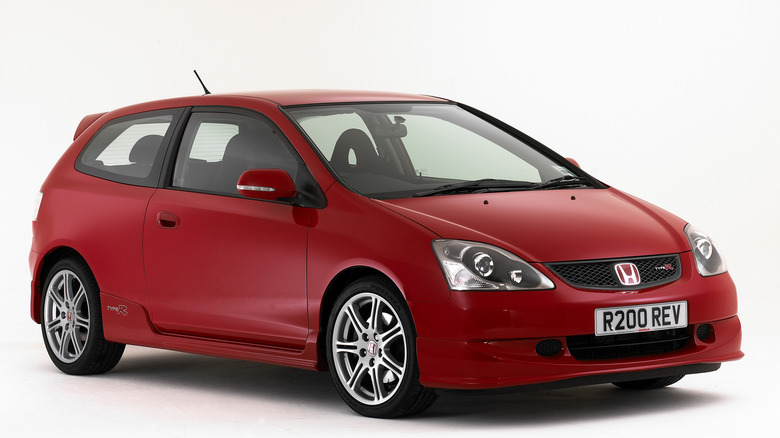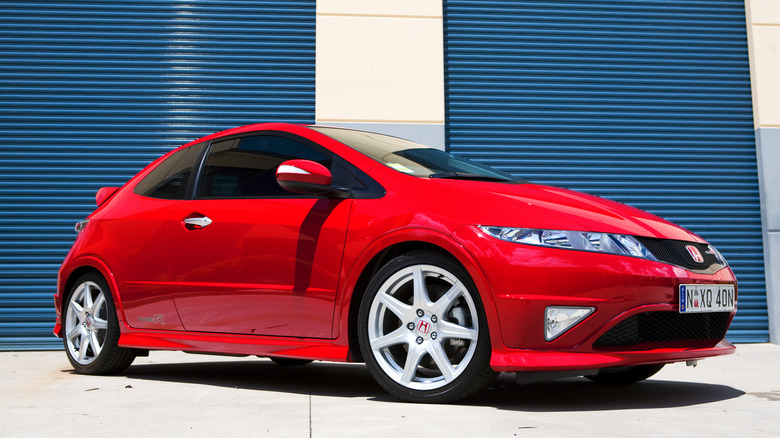Honda’s Type R designation first appeared on the NSX; the NSX-R being a stripped-out, track-ready version of the iconic mid-engine Ferrari fighter. The Championship White paint finish also originates there. Though the NSX-R remains one of the most elusive Hondas in history, the Type R badge would be expanded in the late 90s, when Honda decided to apply it to the Integra, and then the Civic.
The Honda Civic Type R has been around for almost two and a half decades, and the car has shaken up the fiery hot hatchback segment more than once. Initially, that was done through extremely high-revving engines and motorsport expertise. Though the revs have been toned down in recent versions, the motorsport expertise has only improved, creating a truly all-conquering FWD performance car that consistently gives the Germans, and recently, the Koreans something to worry about and attempt to match.
The evolution of this hot hatchback with an incredible story is worth exploring. Hot hatches like the Civic Type R are not too long for this world, so they should be enjoyed while they’re still here.
The Beginning: EK9 (1997)
The EK Civic was the third Honda model to be adorned with the prestigious Type R badge, right after the highly elusive NSX Type R and the famous Integra Type R. Honda chose the Civic SiR as the starting point for the Type R, and then proceeded to beef everything up to 11. Much like the SiR, the EK9 Civic Type R was exclusive to the Japanese domestic market, and it never saw an official global release, save for a couple of examples that were imported to RHD markets.
Under the hood of the EK9 Type R was the iconic B16B 1.6-liter four-cylinder making 185 horsepower. That was pretty solid hot hatch power by the standards of the late 90s, but the CTR’s piece de resistance was when exactly that power arrived: 8,200 rpm. Forced induction was still not a major player in the world of hot hatchbacks around this time, but neither were extremely high-revving powertrains.
That power went to the front wheels through a five-speed manual transmission, which was the sole transmission option. A helical limited-slip differential at the front also took care of the handling, which was, as you might expect, brilliant. Today, the original Civic Type R is the stuff of legend, and assuming that you can find one for sale, you’ll have to part ways with a pretty penny to have one.
More Grown Up, But Still Epic Fun: EP3 (2001)

Heritage Images/Getty Images
After the EK9 Civic Type R won the hearts of car enthusiasts the world over, Honda knew it would be a waste to continue to market it exclusively in Japan. In 2001, the world saw the release of the second Civic Type R, based on the EP or seventh generation Civic. «The world» is quite literal in this case, as this was the first Civic Type R to be offered globally. It was also the first to not be assembled in Japan, but rather Honda’s recently shuttered UK facility in Swindon, where the regular Civic hatch was also assembled.
In terms of styling, the EP3 Type R was a pretty radical departure from the EK9, and its much taller appearance and odd proportions required a bit of time to stomach. Once they were digested, however, this car’s true talents could shine through. Gone was the B16B from the EK9, but in its place came one of Honda’s most celebrated four-cylinder engines: the K20.
Displacing 2.0 liters to the B16’s 1.6, the K20 bumped power up to almost 200 horsepower. Like the EK9, the EP3 also had a giant specific output (horsepower per liter), and the larger engine capacity also bumped up the torque, without sacrificing the stratospheric revving. A much improved six-speed manual transmission, with that party piece high-mounted shifter, was the sole transmission option, while fully independent suspension with a multilink rear setup ensured the EP3 CTR was just as sharp as ever.
A Disappointing Compromise: FN2 (2006)

Felixr/Getty Images
2006 saw the release of the eighth generation Civic. While the sedan version was a little more evolutionary, the hatchback was a proper revolution. It went back to a more traditional hatchback form, but the super angular styling with a triangle motif was vastly different compared to the van-like proportions of the previous one, and it still looks quite modern even to this day. Obviously, this generation brought along a new Type R, the FN2, but there was a problem.
The eighth generation Civic hatchback was significantly larger than the EP, and that meant a good amount of extra weight. Normally, a more powerful engine would fill in for the extra mass, but the FN2 Type R used the same K20 as the EP3, and it had basically no extra power. That meant it was a little slower, taking around 7 seconds to get to 60 mph. Most people could live with that, but the FN2 threw in another disappointment.
To save on costs, the EP3’s multilink rear suspension was ditched in favor of the much less favored torsion beam. As a result, the handling wasn’t as sprightly, and overall, the FN2 just didn’t strike the same chord that the EP3 did. It’s a shame, not only because this was the last naturally aspirated Type R, but also because Honda kept the good stuff for back home…
The JDM Only Sedan Version: FD2 (2006)
While Europe and most other markets got the FN2 Civic Type R, Japan’s Civic Type R from this time was rather special. The FD2 Civic Type R, also known as the FD2R, came as a sedan only. That, in itself, is a little bit unorthodox. Considering what the FD2R offers when compared to the FN2, its larger sedan body style is more easily forgiven. Power came from the same K20 four-cylinder, except the FD2 had more power.
Specifically, 222 horsepower, and it also bumped up torque to 159 lb-ft. To sweeten the deal further, peak power came at a truly ridiculous 8,600 rpm. It not only revved higher than the FN2 Type R, but it also matched or bested many V8-powered Ferrari models. It wasn’t just the raw horsepower that made the FD2 better, the chassis tuning was up to snuff too. Whereas European Civic Type R buyers had to make do with the cost-cutting torsion bar, the FD2 kept the multilink setup, and featured super stiff springs for maximum handling prowess.
Today, the FD2 Civic Type R is quite a rare machine, and even the most beaten-up ones are worth pretty serious money. After the third Civic Type R’s lineage was over, it brought the era of the naturally aspirated Civic Type R down with it. From this point onwards, the Civic Type R was about to explore a brand new frontier: boost.
Turning Up The Boost: FK2 (2015)
2015 saw the introduction of the FK2 Honda Civic Type R, which only a handful of markets enjoyed. The maximum revs no longer started with the number 8, as the Civic Type R finally introduced the inevitable: a turbocharged engine. Gone was the K20A of the previous CTR, and in its place came the K20C1. While it still had VTEC, the redline dropped to only 7,000 rpm, which was still pretty high for an engine with forced induction.
The main benefit of adding a snail to the powertrain was a massive increase in horsepower compared to both the FN2 and the FD2. While those had 197 and 222 horsepower, respectively, the FK2 bumped things up to 306 horsepower, which arrived at 6,500 rpm. With that, the Civic Type R could not only compete with the rest of its hot hatch brethren, all of them being turbocharged by this point, but it could actually beat a lot of them.
Honda’s Dual Axis Strut suspension and standard-fit limited slip differential on the front axle also ensured pin-sharp handling, and it kept any fears of torque steer at bay. This was also the first generation Civic Type R to go wild in the styling department, something that became a bit of a theme, and something that people used to poke fun at the CTR.
A Completely Bonkers Exterior and Crossing The Ocean: FK8 (2018)
2018 saw the release of the FK8 Civic Type R, in itself based on the eleventh-generation Civic. Someone at Honda’s design department thought the spoilered FK2 wasn’t crazy enough, so they worked overtime on the FK8 to create one of the most bonkers-looking hot hatchbacks ever. Some people liked it, but most agreed that the FK8 was a bit too gaudy. The spoiler was even bigger, the wheels decided to skip out on the tire sidewall, and of course, there were the ridiculous vortex generators.
However, unlike most modified Civics you’re probably used to seeing, the FK8 had the performance to back it all up. Power came from an almost identical 2.0-liter K20C1 four-cylinder, with VTEC and a big turbocharger. The FK8 still put out 306 horsepower and 295 lb-ft of torque, though global versions had a little more. FWD was still the norm, and the power reached the wheels exclusively through a six-speed manual transmission and a helical limited-slip differential.
While the FK2 used a torsion beam for the rear, like the FN2, the FK8 brought back the multilink rear setup, which meant that handling was incredibly well-sorted. One of the most important aspects of the FK8 Civic Type R was that it was, finally, the first Honda Civic Type R to be officially sold in North America. After years of enthusiasts begging Honda for one of their best FWD performance cars, it was definitely worth the wait.
A Mature Exterior Hides Even More Capability: FL5 (2023)
Finally, we arrive at the present day. The latest FL5 Honda Civic Type R, based on the eleventh-generation Civic, was introduced for the 2023 model year. Honda must have taken the mostly negative reception of the previous car’s design on board, as the FL5 CTR is much more restrained on the outside. The eleventh-generation Civic is a pretty attractive compact altogether, and while the Type R makes it clear that it’s a Type R, it does so in a much more subtle way.
No more vortex generators or massive winglets or canards. The function is more important than the form here, further evidenced by the fact that most of the aero is now functional, unlike the previous generation. That’s a good thing, as there’s plenty of function: the latest Honda Civic Type R set a FWD production car record at the Nurburgring, lapping the infamous circuit in just 7: 43.8. Examining the details, it’s easy to see why.
Under the hood is another evolution of the K20C1 2.0-liter turbo four-cylinder, and even though it puts out 315 horsepower in North American spec, most global markets turn the wick up to 325 horsepower. Once again, the six-speed manual transmission is mandatory, and despite its remaining FWD, it’s an absolute thrill ride. The Civic Type R is not too long for this world, and it might just be the last ever non-hybrid Honda vehicle. No doubt, the Honda Civic Type R is a hot hatchback worthy of all the celebration and praise it gets.